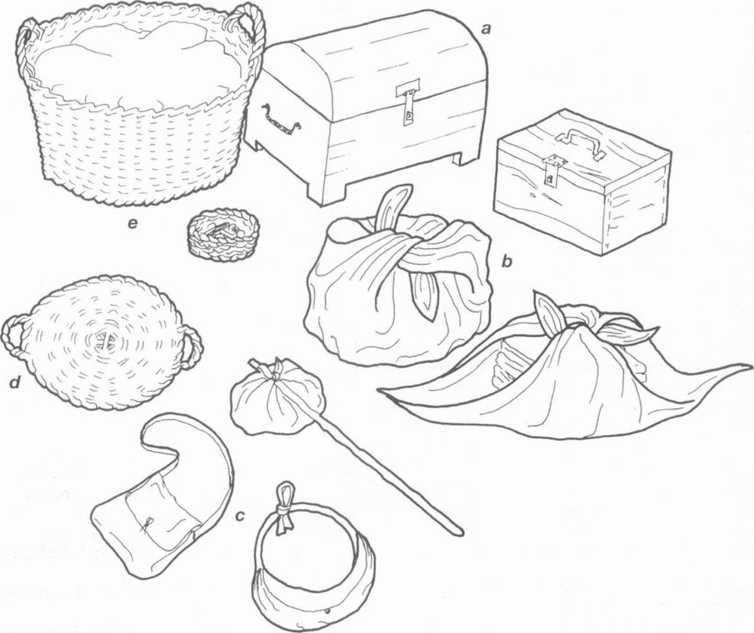tmta"0
6

Hand luggagc
Hand luggage (Fig 6) forms part of an historical character. Every individual would need to carry his possessions. For the wealthy, boxes and coffers would be loaded onto a cart or packhorse. Others might sling their bundle or blanket-roll on their back, or carry a basket at the hip, or on the head (Surcotes, Fig 1). Baskets of all shapes and sizes were used and any modern basket madę of natural willow or rush will look acceptable.
Pilgrims and friars might carry a scrip, iike a smali satchel, and shepherds a distinctive netting or canvas belt bag. Many people travelled very light, however, with just a knife on the belt.
6. Hand luggage
a. Coffers for valuables.
b. Bundles. Tie the pairs of opposite corners to enclose the contents completely. A smali bundle would be carried on a stick; a larger one would be slung over the shoulder.
c. Left Pilgrim's or friar's canvas scrip (wallet or satchel).
Ftight Shepherd's bag.
d. Fiat rush skep, about 50 cm in diameter, also madę in canvas. It might be filled with tools and carried with the two handles together.
e. Baskets. The smali basket can be used to show off your period possessions. The larger basket with its fresh linen covering can be useful for hiding your modern necessities.
220
Wyszukiwarka
Podobne podstrony:
45144 tmta 2 Gorget - See Men s hoods, Fig 6. Grain - Direction of the warp threads on a woven fabri
362 (20) 335 FingerRings the form of a sexfoil, and which is likewise from London, forms part of the
skanowanie0082 (2) comprehension on the part of the students, they will not be able to reproduce it;
http [N-UNC0UNT-U9] An http is a part of an Internet address that allows a Computer to connect to th
1264233p0045906690324?5172905 o 1. You wil! hear part of an interview with Lukę Harding, a young stu
53234 img026 (17) Starting upGrammar 1 The following is part of an article about Parker Brothers, a
essent?rving?29 C A R v I N O. Tl-IF. H l* M A N F I C, f R F. Fig 12.5 Finished małe figurę. (Notę
P1120993 Fig. 1.10: Ovary of an estrous marę with follicles of vaiying shapes. Four smali round foll
2441 Martin Furholt Fig. 12. Example of an irwentory ofthe Baden Pottery Style 6 from Bekasmegyer (a
Blockbouster 2 NPP TESTY I KLUCZE�64 Test 7 BWriting H. This is part of a letter you rcccived from a
Blockbouster 2 NPP TESTY I KLUCZE�60 Test 7 A Writing H. This is part of a letter you received from
więcej podobnych podstron